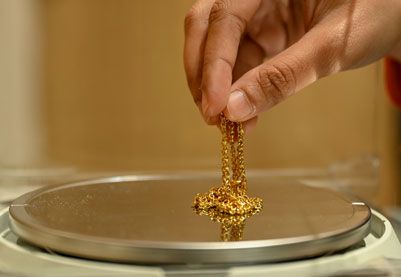White Gold Rate Per Gram Calculation
Understanding white gold price per gram
White gold is a stylish and durable alternative to traditional yellow gold, widely loved for its modern appeal. The white gold price in India is often compared to yellow and rose gold, helping buyers choose the best value option. Usually measured by weight, the white gold price of 10 grams gives a practical idea of its market cost. White gold is an alloy created by mixing pure gold with metals like palladium, silver, or nickel to achieve its white tone. It is often plated with rhodium, which adds a shiny, platinum-like finish and makes it even more attractive.
The price of white gold per gram varies depending on purity, alloy composition, and overall market trends. Understanding these factors allows investors and buyers to make smart decisions. Whether you are purchasing jewellery or exchanging existing pieces, tracking white gold rates ensures better planning and value for money. Checking the live gold price before purchasing ensures a fair deal.
How to calculate the price of 1 gram of white gold?
The price of white gold per gram is calculated based on its gold content and the cost of alloy metals used in its composition. White gold is available in different purities, such as 18K (75% gold) and 14K (58.3% gold), which affect its pricing.
Formula for calculation:
White Gold Price = (Gold Rate per Gram × Gold Purity Percentage) + Alloy Metal Costs
Example:
If the 24K gold rate is Rs. 6,000 per gram and you are buying 18K white gold (75% gold content), the price will be:
(6,000 × 75%) + Alloy Costs = Rs. 4,500 + Alloy Charges
Jewellers may add rhodium plating and making charges, increasing the final price. Always compare rates before buying.
Factors affecting white gold rate per gram
Several factors influence the pricing of white gold, and understanding these elements can help you make informed decisions when purchasing white gold jewellery.
- Gold market prices: White gold is made from pure gold mixed with other alloys, and its price is directly impacted by global gold market fluctuations. Since the base price of white gold is tied to the current gold rate, any increase or decrease in global gold prices will result in a corresponding change in the price of white gold. This makes it important for buyers to stay updated on the gold market, as prices can fluctuate frequently.
- Purity levels: White gold comes in various purity levels, with 18K and 22K being the most common. Higher purity white gold, such as 22K, contains more gold content, making it more expensive than lower purity options like 14K or 10K. The higher the gold content, the more costly the jewellery, as pure gold is priced higher in the market.
- Alloy composition: White gold is created by alloying pure gold with other metals, such as palladium, nickel, or silver. The inclusion of metals like palladium, which is relatively expensive, increases the overall cost of white gold. Palladium is used for its strength and ability to maintain the white appearance, but it comes at a premium price.
- Rhodium plating costs: One of the distinguishing characteristics of white gold is the rhodium plating that gives it its shiny, white finish. Rhodium is a rare and expensive metal, and the plating process adds to the cost of white gold jewellery. The plating also tends to wear off over time, requiring re-plating, which can result in additional maintenance costs.
- Jeweller’s charges: The final price of white gold jewellery is also affected by the jeweller’s making charges. These charges cover the labour, craftsmanship, and design complexity involved in creating the piece. Intricate or customised designs require more effort and time, which raises the making charges. Additionally, jewellers often include design fees based on the level of skill and precision required for the piece, further increasing the cost.
By considering these factors, buyers can better understand what drives the cost of white gold and make smarter purchasing decisions based on their preferences and budget.
Turn your gold into instant support—handle any expense with ease. Check your gold loan eligibility and access funds when you need them most.
Comparing white gold prices with yellow and rose gold
When considering the cost and value of gold, several factors come into play that differentiate yellow, white, and rose gold. These factors can impact their pricing and long-term value.
- Base gold price: All three types of gold—yellow, white, and rose—are primarily priced based on their purity and weight. The gold content in each karat (e.g., 24K, 22K, 18K) determines the base price, with higher purity gold costing more due to the higher content of gold. The weight of the piece also plays a key role in the pricing, as the more gold it contains, the more expensive it will be.
- Alloy composition: White gold is made by alloying pure gold with metals like palladium or nickel, which gives it its distinctive white appearance. Palladium, in particular, tends to be more expensive, raising the overall cost. Rose gold, on the other hand, contains copper, which gives it a pinkish hue but is typically cheaper than palladium, thus slightly lowering its cost compared to white gold.
- Rhodium plating: White gold often requires rhodium plating to enhance its shine and provide a durable finish. Rhodium is a precious metal, and the plating adds to the cost. Since the rhodium plating wears off over time, the need for re-plating adds an additional cost, which is not a concern for yellow and rose gold jewellery.
- Durability and maintenance: White gold’s durability is high, but it does require periodic maintenance, such as re-plating with rhodium to maintain its luster. Over time, the plating may wear off, leading to a decrease in its shine. This maintenance cost is an added long-term expense that buyers need to factor in. In contrast, yellow and rose gold generally require less upkeep, making them more cost-effective in the long run.
- Resale value: While all types of gold retain value, yellow gold has a higher resale demand, primarily due to its traditional and universal appeal. It's often seen as more valuable in the resale market, especially in countries like India, where yellow gold is preferred. White and rose gold, however, are more valued for their design, and while they may not fetch the same resale price as yellow gold, their unique aesthetic qualities make them highly sought after in the jewellery market.
Understanding these factors will help you make an informed decision when purchasing or selling gold jewellery, as the type of gold, its maintenance needs, and market demand all influence the overall pricing and value.
Where to find the best price for white gold per gram?
When looking to purchase or value white gold, there are several avenues to explore that offer competitive pricing and transparency.
- Jewellery stores: Reputable jewellery stores are a good starting point for buying white gold. Established jewellers often follow standardised pricing based on the current market value of gold, ensuring you pay a fair price. They also offer guarantees of quality and authenticity, which is important when investing in precious metals.
- Online jewellery platforms: Websites like Tanishq, Malabar Gold, and other trusted online platforms offer the convenience of browsing prices from home. These platforms frequently update their prices according to market fluctuations, allowing customers to compare rates before making a purchase. Online stores also tend to have promotions or discounts that can make purchasing more affordable.
- Gold price tracking apps: Using apps dedicated to tracking gold prices can help you stay updated with the live rates of white gold. These apps provide real-time price updates, which are especially useful for buyers and investors looking to make their purchase at the optimal time.
- Financial institutions: Some banks and financial institutions, such as Bajaj Finance, offer gold loan services and may provide white gold valuation for collateral purposes. This is a convenient option for those who wish to assess the value of their gold before applying for a loan or making a purchase.
- Wholesale markets: Buying in bulk from wholesale markets or directly from manufacturers often reduces the cost per gram of white gold. If you’re purchasing large quantities, this can be a cost-effective way to acquire white gold at lower rates, as bulk buyers typically receive discounts due to economies of scale.
Current market trends and white gold price fluctuations
Several factors impact the pricing of white gold, and understanding these elements can help you navigate fluctuations in the market effectively.
- Global gold rates: White gold prices are closely linked to global gold prices, which are set by international bullion markets. Since white gold is primarily made from yellow gold mixed with other alloys, any change in the price of gold on the global stage directly affects the price of white gold. As global gold rates rise or fall, white gold follows suit, resulting in price changes in the local market.
- Currency exchange rates: The value of the Indian Rupee against the US Dollar has a significant effect on white gold pricing. Since gold is traded internationally in US dollars, a weaker rupee increases the cost of importing gold into India, thereby raising the price of white gold in the local market.
- Inflation impact: Economic inflation can drive up the demand for gold, as it is considered a hedge against inflation. As inflation rises, more people turn to gold, driving up its price, including white gold. This demand surge influences the overall pricing in the market.
- Seasonal demand: Festivals like Diwali and wedding seasons lead to a spike in gold purchases. During these times, the demand for white gold jewellery increases, which can lead to higher prices as jewellers raise rates to meet the surge in consumer interest.
- Jewellery trends: Changing consumer preferences also play a role in white gold pricing. As trends shift towards more modern or unique jewellery designs, the demand for white gold increases. New styles or celebrity endorsements can make white gold jewellery more popular, driving up its price due to higher demand.
By staying informed about these factors, buyers can make better purchasing decisions and anticipate when white gold prices may rise or fall.
Wondering how much you can borrow on your gold? Just check your gold loan eligibility—it takes seconds and minimal paperwork!
What affects the price of white gold per gram?
White gold pricing is influenced by several factors, including gold purity, alloy composition, and external market conditions. The purity of gold, typically 18K or 22K, plays a key role in determining the base price. White gold is an alloy, often mixed with metals like palladium or silver, and the cost of these metals affects the final price. Palladium, in particular, is a significant contributor to the cost of white gold, as its price tends to be higher than other metals.
Additionally, rhodium plating is often applied to white gold to give it a shiny finish. This plating adds extra costs, making white gold more expensive than yellow gold. Economic trends, such as inflation or global financial instability, can cause fluctuations in the price of white gold. The value of the Indian Rupee against the US Dollar and market demand also contribute to price variations. Understanding these factors can help buyers make informed decisions when purchasing white gold.
Is white gold more expensive than yellow gold?
White gold is often priced slightly higher than yellow gold due to the additional costs of rhodium plating and alloy metals like palladium. However, the yellow gold price remains higher in resale value due to its traditional demand and lack of additional maintenance costs. White gold’s final cost also depends on design complexity and making charges, making it a premium choice for jewellery buyers.
How to buy white gold at competitive prices?
When buying white gold, securing competitive prices requires a strategic approach. To get the best value, it is important to monitor market trends and make purchases during price dips or off-season sales when gold rates tend to be lower. This timing can significantly reduce costs, allowing you to secure better deals.
Opting for standard designs, rather than intricate or customised jewellery, can also help minimise additional costs. Customised designs often incur higher making charges due to the labour and complexity involved. By choosing simpler, ready-made pieces, you can reduce these charges while still purchasing beautiful white gold jewellery. It is crucial to check multiple jewellers and online stores before making a purchase. Comparing prices across different platforms helps you ensure fair pricing and avoid overpaying. Be mindful of the additional costs like GST, making charges, or hidden fees, which can impact the total cost.
Understanding white gold’s purity and alloy composition is also essential. White gold is typically an alloy of yellow gold, mixed with metals such as palladium or nickel to give it a white finish. Knowing the karat value and the composition of the alloy will help you make informed decisions and get the best price for your investment.
For the best deals, consider exploring gold loan options with Bajaj Finserv Gold Loan, which offers competitive rates for your white gold jewellery.
Apply in minutes. Money in account instantly with a Bajaj Finserv Gold Loan*
Related Articles
Disclaimer
Bajaj Finance Limited has the sole and absolute discretion, without assigning any reason to accept or reject any application. Terms and conditions apply*.
For customer support, call Personal Loan IVR: 7757 000 000









 Personal Loan
Personal Loan Check Eligibility
Check Eligibility Salaried Personal Loan
Salaried Personal Loan EMI Calculator
EMI Calculator Account Aggregator
Account Aggregator Credit Pulse Report
Credit Pulse Report
 Deals starting @99
Deals starting @99 Festive deals
Festive deals Min. 50% off
Min. 50% off
 Wallet to Bank
Wallet to Bank
 Easy EMI Loan
Easy EMI Loan Savings Offer
Savings Offer Smartphones
Smartphones Led TVs
Led TVs Washing Machines
Washing Machines Laptops
Laptops Refrigerators
Refrigerators Air Conditioner
Air Conditioner Air Coolers
Air Coolers
 Loan Against Shares
Loan Against Shares Loan Against Mutual Funds
Loan Against Mutual Funds Loan Against Insurance Policy
Loan Against Insurance Policy ESOP Financing
ESOP Financing Easy EMI Loan
Easy EMI Loan Two-wheeler Loan
Two-wheeler Loan Loan for Lawyer
Loan for Lawyer Industrial Equipment Finance
Industrial Equipment Finance Industrial Equipment Balance Transfer
Industrial Equipment Balance Transfer Industrial Equipment Refinance
Industrial Equipment Refinance Personal Loan Branch Locator
Personal Loan Branch Locator Used Tractor Loan
Used Tractor Loan Loan Against Tractor
Loan Against Tractor Tractor Loan Balance Transfer
Tractor Loan Balance Transfer
 Two-wheeler Loan
Two-wheeler Loan Bike
Bike Scooter
Scooter Electric Vehicle
Electric Vehicle Best Sellers
Best Sellers Popular Brands
Popular Brands

 Trading Account
Trading Account Open Demat Account
Open Demat Account Margin Trading Financing
Margin Trading Financing Share Market
Share Market Invest in IPO
Invest in IPO All stocks
All stocks Top gainers
Top gainers Top losers
Top losers 52 week high
52 week high 52 week low
52 week low Loan against shares
Loan against shares
 Home Loan
Home Loan Transfer your existing Home loan
Transfer your existing Home loan Loan against Property
Loan against Property Home Loan for Salaried
Home Loan for Salaried Home loan for self employed
Home loan for self employed Home Loan EMI Calculator
Home Loan EMI Calculator Home Loan eligibility calculator
Home Loan eligibility calculator Home Loan balance transfer
Home Loan balance transfer
 Term Life Insurance
Term Life Insurance ULIP Plan
ULIP Plan Savings Plan
Savings Plan Family Insurance
Family Insurance Senior Citizen Health Insurance
Senior Citizen Health Insurance Critical Illness Insurance
Critical Illness Insurance Child Health Insurance
Child Health Insurance Pregnancy and Maternity Health Insurance
Pregnancy and Maternity Health Insurance Individual Health Insurance
Individual Health Insurance Low Income Health Insurance
Low Income Health Insurance Student Health Insurance
Student Health Insurance Group Health Insurance
Group Health Insurance Retirement Plans
Retirement Plans Child Plans
Child Plans Investment Plans
Investment Plans
 Business Loan
Business Loan Secured Business Loan
Secured Business Loan Loan against property
Loan against property Loans against property balance transfer
Loans against property balance transfer Loan against shares
Loan against shares Home Loan
Home Loan Loans against mutual funds
Loans against mutual funds Loan against bonds
Loan against bonds Loan against insurance policy
Loan against insurance policy
 Apply for Gold Loan
Apply for Gold Loan Transfer your Gold Loan with Us
Transfer your Gold Loan with Us Gold Loan Branch Locator
Gold Loan Branch Locator
 ULIP Plan
ULIP Plan Savings Plan
Savings Plan Retirement Plans
Retirement Plans Child Plans
Child Plans Free Demat Account
Free Demat Account Invest in Stocks
Invest in Stocks Invest in IPO
Invest in IPO Margin Trading Facility
Margin Trading Facility Fixed Deposit Branch Locator
Fixed Deposit Branch Locator
 Check your Credit Score
Check your Credit Score
 New Car Loan
New Car Loan Used Car Loan
Used Car Loan Loan Against Car
Loan Against Car Car Loan Balance Transfer and Top-up
Car Loan Balance Transfer and Top-up
 Get Bajaj Prime
Get Bajaj Prime
 Mobiles on EMI
Mobiles on EMI Electronics on EMI Offer
Electronics on EMI Offer  Iphone on EMI
Iphone on EMI LED TV on EMI
LED TV on EMI Refrigerator on EMI
Refrigerator on EMI Laptop on EMI
Laptop on EMI Kitchen appliances on EMI
Kitchen appliances on EMI Washing machines
Washing machines
 Personal Loan EMI Calculator
Personal Loan EMI Calculator Personal Loan Eligibility Calculator
Personal Loan Eligibility Calculator Home Loan EMI Calculator
Home Loan EMI Calculator Home Loan Eligibility Calculator
Home Loan Eligibility Calculator Good & Service Tax (GST) Calculator
Good & Service Tax (GST) Calculator Flexi Day Wise Interest Calculator
Flexi Day Wise Interest Calculator Flexi Transaction Calculator
Flexi Transaction Calculator Secured Business Loan Eligibility Calculator
Secured Business Loan Eligibility Calculator Fixed Deposits Interest Calculator
Fixed Deposits Interest Calculator Two wheeler Loan EMI Calculator
Two wheeler Loan EMI Calculator New Car Loan EMI Calculator
New Car Loan EMI Calculator Used Car Loan EMI Calculator
Used Car Loan EMI Calculator All Calculator
All Calculator Used Tractor Loan EMI Calculator
Used Tractor Loan EMI Calculator
 Hot Deals
Hot Deals Clearance Sale
Clearance Sale Kitchen Appliances
Kitchen Appliances Tyres
Tyres Camera & Accessories
Camera & Accessories Mattresses
Mattresses Furniture
Furniture Watches
Watches Music & Audio
Music & Audio Cycles
Cycles Mixer & Grinder
Mixer & Grinder Luggage & Travel
Luggage & Travel Fitness Equipment
Fitness Equipment Fans
Fans
 Personal Loan for Doctors
Personal Loan for Doctors Business loan for Doctors
Business loan for Doctors Medical Equipment Finance
Medical Equipment Finance Secured Business Loan
Secured Business Loan Loan against property
Loan against property Secured Business Loan Balance Transfer
Secured Business Loan Balance Transfer Loan against share
Loan against share Gold Loan
Gold Loan Home Loan
Home Loan
 Engagement Zone
Engagement Zone Game Zone
Game Zone
 Savings Offer
Savings Offer Easy EMI
Easy EMI Offer World
Offer World 1 EMI OFF
1 EMI OFF New Launches
New Launches Zero Down Payment
Zero Down Payment Clearance Sale
Clearance Sale Bajaj Mall Sale
Bajaj Mall Sale
 Mobiles under ₹20,000
Mobiles under ₹20,000 Mobiles under ₹25,000
Mobiles under ₹25,000 Mobiles under ₹30,000
Mobiles under ₹30,000 Mobiles under ₹35,000
Mobiles under ₹35,000 Mobiles under ₹40,000
Mobiles under ₹40,000 Mobiles under ₹50,000
Mobiles under ₹50,000
 Articles
Articles
 Overdue Payments
Overdue Payments Other Payments
Other Payments
 Document Center
Document Center Bank details & Documents
Bank details & Documents Tax Invoice Certificate
Tax Invoice Certificate
 Do Not Call Service
Do Not Call Service
 Hamara Mall Orders
Hamara Mall Orders

 Check Loan Offer
Check Loan Offer Mobiles on EMI
Mobiles on EMI Trade directly with your Demat A/c
Trade directly with your Demat A/c ITR
ITR My Garage
My Garage
 Live Videos - Beta
Live Videos - Beta
 Savings Offer
Savings Offer Smartphones
Smartphones LED TVs
LED TVs Washing Machines
Washing Machines Laptops
Laptops Refrigerators
Refrigerators Air Conditioners
Air Conditioners Air Coolers
Air Coolers Water Purifiers
Water Purifiers Tablets
Tablets Kitchen Appliances
Kitchen Appliances Mattresses
Mattresses Furniture
Furniture Music and Audio
Music and Audio Cameras & Accessories
Cameras & Accessories Cycle
Cycle Watches
Watches Tyres
Tyres Luggage & Travel
Luggage & Travel Fitness Equipment
Fitness Equipment Tractor
Tractor Easy EMI Loan
Easy EMI Loan
 vivo Mobiles
vivo Mobiles OPPO Mobiles
OPPO Mobiles Xiaomi Mobiles
Xiaomi Mobiles Sony LED TVs
Sony LED TVs Samsung LED TVs
Samsung LED TVs LG LED TVs
LG LED TVs Haier LED TVs
Haier LED TVs Godrej Refrigerators
Godrej Refrigerators Voltas Washing Machines
Voltas Washing Machines





